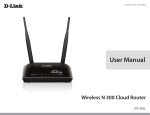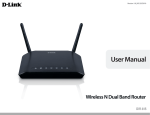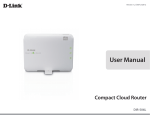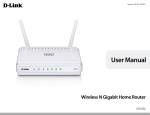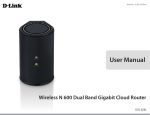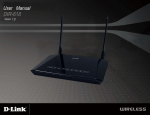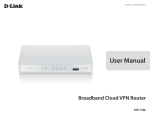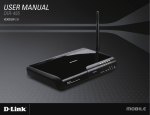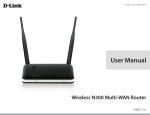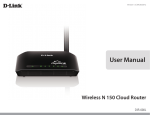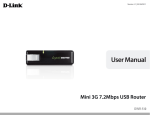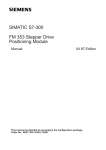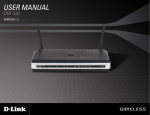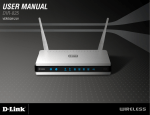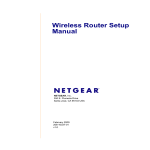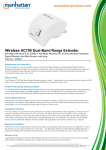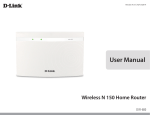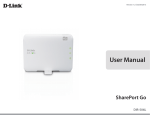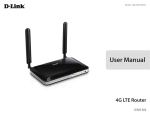Download User Manual - D-Link
Transcript
Version 1.01 | 2015/9/7 User Manual Wireless AC750 Dual Band Router DIR-809 Preface D-Link reserves the right to revise this publication and to make changes in the content hereof without obligation to notify any person or organization of such revisions or changes. Manual Revisions Revision Date Description 1.01 September 7, 2015 • Initial release for revision A3 Trademarks D-Link and the D-Link logo are trademarks or registered trademarks of D-Link Corporation or its subsidiaries in the United States or other countries. All other company or product names mentioned herein are trademarks or registered trademarks of their respective companies. Copyright © 2015 by D-Link Corporation, Inc. All rights reserved. This publication may not be reproduced, in whole or in part, without prior expressed written permission from D-Link Corporation, Inc. D-Link DIR-809 User Manual i Table of Contents Table of Contents Preface.................................................................................. i Product Overview............................................................... 1 Package Contents.......................................................................... 1 System Requirements.................................................................. 2 Introduction.................................................................................... 3 Features............................................................................................. 4 Hardware Overview...................................................................... 5 Connections............................................................................ 5 LEDs............................................................................................ 6 Installation.......................................................................... 7 Before you Begin............................................................................ 7 Wireless Installation Considerations....................................... 8 Manual Setup.................................................................................. 9 Configuration....................................................................11 Easy Setup Wizard.......................................................................12 Internet Connection...........................................................13 Wireless Connection...........................................................13 Advanced Network Configuration........................................15 Internet Connection Type (Manual Configuration).17 Dynamic IP (DHCP).........................................................18 Static (assigned by ISP).................................................19 PPPoE (Username / Password)...................................20 PPTP.....................................................................................22 L2TP.....................................................................................24 D-Link DIR-809 User Manual Wireless Settings..................................................................26 Wireless Router Mode...................................................26 Access Point Mode.........................................................27 Repeater Mode................................................................28 Wireless Router Mode........................................................29 2.4G Wireless Network Settings.................................29 5G Wireless Network Settings....................................30 Wireless Security..................................................................31 What is WPA?....................................................................31 2.4G/5G Wireless Security Mode...............................32 AP Mode..................................................................................34 Repeater 2.4 GHz Mode.....................................................35 Repeater 5 GHz Mode........................................................37 Network Settings.................................................................39 Router Settings................................................................39 DHCP Server Settings....................................................40 DHCP Reservation..........................................................41 Advanced................................................................................42 Virtual Server....................................................................42 Port Forwarding..............................................................43 Application Rules............................................................44 MAC Filter..........................................................................45 Website Filters..................................................................46 Traffic Control...................................................................47 Firewall Settings..............................................................48 2.4G Advanced Wireless...............................................50 ii Table of Contents 5G Advanced Wireless...................................................51 Advanced Network Settings.......................................52 Wi-Fi Protected Setup........................................................54 Wi-Fi Protected Setup Wizard..........................................55 Tools.........................................................................................57 Admin.................................................................................57 Time.....................................................................................58 System................................................................................59 Firmware............................................................................60 Language Pack.................................................................60 Dynamic DNS...................................................................61 System Check...................................................................62 Status.......................................................................................63 Device Info........................................................................63 Logs.....................................................................................64 Statistics.............................................................................65 Internet Sessions.............................................................66 Wireless..............................................................................67 Support...................................................................................68 WPS/WCN 2.0........................................................................82 Windows® XP.................................................................................83 WPA/WPA2.............................................................................84 Troubleshooting...............................................................86 Wireless Basics..................................................................90 What is Wireless?..........................................................................91 Tips....................................................................................................93 Wireless Modes.............................................................................94 Networking Basics............................................................95 Check your IP address................................................................95 Statically Assign an IP address................................................96 Technical Specifications...................................................97 Connect a Wireless Client to your Router.......................69 WPS Button....................................................................................69 Windows® 8....................................................................................70 WPA/WPA2.............................................................................70 Windows® 7....................................................................................72 WPA/WPA2.............................................................................72 WPS...........................................................................................75 Windows Vista®.............................................................................79 WPA/WPA2.............................................................................80 D-Link DIR-809 User Manual iii Section 1 - Product Overview Product PackageOverview Contents DIR-809 Wireless AC750 Dual Band Router Ethernet Cable Power Adapter Wi-Fi Configuration Note Wi-Fi Configuration Note CD-ROM If any of the above items are missing, please contact your reseller. Note: Using a power supply with a different voltage rating than the one included with the DIR-809 will cause damage and void the warranty for this product. D-Link DIR-809 User Manual 1 Section 1 - Product Overview System Requirements Network Requirements • An Ethernet-based Cable or DSL modem • IEEE 802.11ac, 802.11a, 802.11n or 802.11g wireless clients • 10/100 Ethernet Computer with the following: • Windows®, Apple® Mac OS®, or Linuxbased operating system • An installed Ethernet adapter Web-based Configuration Utility Requirements Browser Requirements: Microsoft Internet Explorer® 9, Mozilla® Firefox® 20.0, Google® Chrome® 25.0, or Safari® 5.1 or higher version Windows® Users: Make sure you have the latest version of Java installed. Visit www.java.com to download the latest version. D-Link DIR-809 User Manual 2 Section 1 - Product Overview Introduction The D-Link DIR-809 is a IEEE 802.11ac compliant device that delivers up to three times faster speeds than 802.11n while staying backward compatible with 802.11a/g/b devices. Connect the DIR-809 to a Cable or DSL modem and provide high-speed Internet access to multiple computers, game consoles, and media players. Create a secure wireless network to share photos, files, music, videos, printers, and network storage. Powered by the 802.11ac technology this router provides wireless coverage for homes and offices, or for users running bandwidth-intensive applications. With some routers, all wired and wireless traffic, including VoIP, Video Streaming, Online Gaming, and Web browsing are mixed together into a single data stream. By handling data this way, applications like video streaming could pause or delay. With D-Link Intelligent QoS Technology, wired and wireless traffic are analyzed and separated into multiple data streams. The DIR-809 supports the latest wireless security features to help prevent unauthorized access, be it from over a wireless network or the Internet. Support for WPA™ and WPA2™ standards ensure that you will be able to use the best possible encryption regardless of your client devices. In addition, this router utilizes Dual Active Firewalls (SPI and NAT) to prevent potential attacks from across the Internet so you and your family can browser the Internet with peace-of-mind. D-Link DIR-809 User Manual 3 Section 1 - Product Overview Features •Ultimate Fast Wireless Networking - The DIR-809 provides up to 300 Mbps wireless bandwidth in the 2.4 GHz band and up to 433 Mbps wireless bandwidth in the 5 GHz band with other 802.11ac and draft 802.11n wireless clients. This capability allows users to participate in real-time activities online, such as video streaming, online gaming, and real-time audio. The performance of this 802.11ac wireless router gives you the freedom of wireless networking at speeds 3x faster than 802.11n. • Compatible with 802.11a/g/n Devices - The DIR-809 is compatible with the IEEE 802.11a, 802.11g, and 802.11n wireless standards, so it can connect with existing networking devices as well as PCI, USB, and CardBus network adapters. • Advanced Firewall Features - The Web-based user interface displays a number of advanced network management features including: • Content Filtering - Easily applied content filtering based on MAC address or URL. • Secure Multiple/Concurrent Sessions - The DIR-809 can pass through VPN sessions. It supports multiple and concurrent IPSec and PPTP sessions, so users behind the DIR-809 can securely access corporate networks. •User-friendly Easy Setup Wizard - Through its easy-to-use Web-based user interface, the DIR-809 lets you quickly and easily configure your router, letting you surf the Internet within minutes. * Maximum wireless signal rate derived from IEEE Standard 802.11a, 802.11g, 802.11n and draft 802.11ac specifications. Actual data throughput will vary. Network conditions and environmental factors, including volume of network traffic, building materials and construction, and network overhead, lower actual data throughput rate. Environmental conditions will adversely affect wireless signal range. D-Link DIR-809 User Manual 4 Section 1 - Product Overview Hardware Overview Connections 1 1 2 3 4 2 3 4 10/100 Ethernet devices such as computers, switches, storage (NAS) devices LAN Ports (1 - 4) Connect and game consoles. Internet Port Using an Ethernet cable, connect your broadband modem to this port. Power Connector Connector for the supplied power adapter. WPS & Reset Button D-Link DIR-809 User Manual Press and hold the button for 1-7 seconds to activate WPS-PBC Discovery Mode. Press and hold the button for at least 8 seconds to reset the router to default settings. 5 Section 1 - Product Overview Hardware Overview LEDs 1 1 Power LED 2 Internet LED 2 3 4 5 A solid green light indicates a proper connection to the power supply. A solid light indicates connection on the Internet port. 3 WPS LED This LED blinks during WPS handshake phase. 4 WLAN A solid light indicates that the wireless segment is ready. 5 Local Network LEDs A solid light indicates a connection to an Ethernet-enabled computer on ports 1-4. D-Link DIR-809 User Manual 6 Section 2 - Installation Installation This section will walk you through the installation process. Placement of the router is very important. Do not place the router in an enclosed area such as a closet, cabinet, or in an attic or garage. Before you Begin • Please configure the router with the computer that was last connected directly to your modem. • You can only use the Ethernet port on your modem. If you were using the USB connection before using the router, then you must turn off your modem, disconnect the USB cable and connect an Ethernet cable to the Internet port on the router, and then turn the modem back on. In some cases, you may need to call your ISP to change connection types (USB to Ethernet). • If you have DSL and are connecting via PPPoE, make sure you disable or uninstall any PPPoE software such as WinPoet, Broadjump, or Enternet 300 from your computer or you will not be able to connect to the Internet. D-Link DIR-809 User Manual 7 Section 2 - Installation Wireless Installation Considerations The D-Link wireless router lets you access your network using a wireless connection from virtually anywhere within the operating range of your wireless network. Keep in mind, however, that the number, thickness and location of walls, ceilings, or other objects that the wireless signals must pass through, may limit the range. Typical ranges vary depending on the types of materials and background RF (radio frequency) noise in your home or business. The key to maximizing wireless range is to follow these basic guidelines: 1.Keep the number of walls and ceilings between the D-Link router and other network devices to a minimum each wall or ceiling can reduce your adapter’s range from 3-90 feet (1-30 meters.) Position your devices so that the number of walls or ceilings is minimized. 2. Be aware of the direct line between network devices. A wall that is 1.5 feet thick (.5 meters), at a 45-degree angle appears to be almost 3 feet (1 meter) thick. At a 2-degree angle it looks over 42 feet (14 meters) thick! Position devices so that the signal will travel straight through a wall or ceiling (instead of at an angle) for better reception. 3. Building Materials make a difference. A solid metal door or aluminum studs may have a negative effect on range. Try to position access points, wireless routers, and computers so that the signal passes through drywall or open doorways. Materials and objects such as glass, steel, metal, walls with insulation, water (fish tanks), mirrors, file cabinets, brick, and concrete will degrade your wireless signal. 4.Keep your product away (at least 3-6 feet or 1-2 meters) from electrical devices or appliances that generate RF noise. 5. If you are using 2.4 GHz cordless phones or X-10 (wireless products such as ceiling fans, lights, and home security systems), your wireless connection may degrade dramatically or drop completely. Make sure your 2.4 GHz phone base is as far away from your wireless devices as possible. The base transmits a signal even if the phone in not in use. D-Link DIR-809 User Manual 8 Section 2 - Installation Manual Setup 1.Turn off and unplug your cable or DSL broadband modem. This is required. Modem 2.Position your router close to your modem and a computer. Place the router in an open area of your intended work area for better wireless coverage. 3. Unplug the Ethernet cable from your modem (or existing router if upgrading) that is connected to your computer. Plug it into the LAN port labeled 1 on the back of your router. The router is now connected to your computer. DIR-809 Computer D-Link DIR-809 User Manual 9 Section 2 - Installation 4.Plug one end of the included blue Ethernet cable that came with your router into the yellow port labeled INTERNET on the back of the router. Plug the other end of this cable into the Ethernet port on your modem. Computer DIR-809 Modem INTERNET 5.Reconnect the power adapter to your cable or DSL broadband modem and wait for two minutes. 6. Connect the supplied power adapter into the power port on the back of the router and then plug it into a power outlet or surge protector. The power LED will light up. Allow 1 minute for the router to boot up. Computer DIR-809 Modem INTERNET 7.If you are connecting to a Broadband service that uses a dynamic connection (not PPPoE), you may be online already. Try opening a web browser and enter a web site address. D-Link DIR-809 User Manual 10 Section 3 - Configuration Configuration There are several different ways you can configure your router to connect to the Internet and connect to your clients: • D-Link Easy Setup Wizard - This wizard will launch when you log into the router for the first time. Refer to page 12. • Manual Setup - Log into the router and manually configure your router (advanced users only). Refer to page 15. D-Link DIR-809 User Manual 11 Section 3 - Configuration Easy Setup Wizard If this is your first time using the router, open your web browser. You will automatically be directed to the Wizard Setup Screen. If not, type http:// dlinkrouter.local./ or 192.168.0.1 into the address bar and press Enter. The username, “admin” will already be filled in. Leave the password blank and press the login button. If you would like to manually set up the router, please refer to the Web-Based Configuration Utility section on page 15. The Easy Setup Wizard consists of two parts: Internet Connection and Wireless Connection. D-Link DIR-809 User Manual 12 Section 3 - Configuration Internet Connection First select the INTERNET connection type. The options are Static IP, Dynamic IP (DHCP), and PPPoE(Username / Password). Dynamic IP (DHCP) The router will attempt to automatically configure itself for Dynamic IP Internet Connections. Static IP Enter the IP and DNS settings supplied by your ISP. PPPoE Enter your username and user password details provided by your Internet Service Provider. This option is typically used for DSL Internet service. Note: Make sure to remove your PPPoE software from your computer. The software is no longer needed and will not work through a router. Wireless Connection Next, create a Wi-Fi network name (SSID) for both the 2.4 GHz and 5 GHz segments using up to 32 characters. Create a Wi-Fi password (between 8-63 characters). Your wireless clients will need to have this passphrase or key in order to connect to your wireless network. Click Connect to continue. D-Link DIR-809 User Manual 13 Section 3 - Configuration Please wait while your router detects your Internet connection type. If you selected PPPoE as your Internet connection, you may need to enter information provided by you ISP, such as username and password. Congratulations, your router setup is complete. Upon clicking Complete you will be redirected to the www.dlink.com may now freely use the Internet. If the router does not detect a valid Ethernet connection from the Internet port, this screen will appear. Verify your broadband modem is connected to the Internet port and then click Try Again. D-Link DIR-809 User Manual 14 Section 3 - Configuration Advanced Network Configuration If this is your first time using the router, open your web browser. You will automatically be directed to the Wizard Setup Screen. If not, type http:// dlinkrouter.local./ or 192.168.0.1 into the address bar and press Enter. The username, “admin” will already be filled in. Leave the password blank and press the login button. Upon login, bypass the Easy Setup by clicking Advanced Network in the bottom right hand corner of the page. D-Link DIR-809 User Manual 15 Section 3 - Configuration Upon clicking the “Advanced Network” option, you will be brought to the Setup - Internet page. From this page you can configure your connection and router settings manually. If you want to configure your router to connect to the Internet using the wizard, click Easy Setup. You will be directed back to the Easy Setup Wizard. Refer to the previous section. D-Link DIR-809 User Manual 16 Section 3 - Configuration Internet Connection Type (Manual Configuration) Internet Connection Type In this section, the user can select from a list of Internet Connection types that can be configured and used on this router. Options to choose from are Static IP, Dynamic IP, PPPoE, PPTP, and L2TP. After selecting a specific Internet Connection type, this page will automatically refresh and provide unique fields to configure related to the specified Internet Connection type. At any given point the user can save the configuration by clicking on the Save Settings button. If you choose to discard the changes made, click on the Don’t Save Settings button. D-Link DIR-809 User Manual 17 Section 3 - Configuration Dynamic IP (DHCP) My Internet Connection is: Dynamic IP (DHCP) This option allows the router to obtain an IP address automatically from the WAN device that is connected to the Internet port. Note: If you’re not sure about the type of Internet Connection you have, please contact your Internet Service Provider (ISP) for assistance. After selecting Dynamic IP, the following parameters will be available for configuration: Host Name: The Host Name is optional but may be required by some ISPs. Leave blank if you are not sure. MAC The default MAC Address is set to the Internet port’s physical interface Address: MAC address on the Broadband Router. It is not recommended that you change the default MAC address unless required by your ISP. You can use the Clone Your PC’s MAC Address button to replace the Internet port’s MAC address with the MAC address of your Ethernet card. Primary DNS: Enter the Primary DNS IP address used here. Secondary Enter the Secondary DNS IP address used here. This field is normally DNS: optional. Only one DNS address is required for a functional Internet connection, but using a second DNS address provides more stability. MTU: Maximum Transmission Unit - you may need to change the MTU for optimal performance with your specific ISP. 1500 is the default MTU. D-Link DIR-809 User Manual 18 Section 3 - Configuration Static (assigned by ISP) My Internet Connection is: Static IP Select Static IP Address if all the Internet port’s IP information is provided to you by your ISP. You will need to enter in the IP address, subnet mask, gateway address, and DNS address(es) provided to you by your ISP. Each IP address entered in the fields must be in the appropriate IP form, which are four octets separated by a dot (x.x.x.x). The Router will not accept the IP address if it is not in this format. My Internet Select Static IP to manually enter the IP settings supplied by your ISP. Connnection IP Address: Enter the Static IP address provided by the ISP here. Subnet Mask: Enter the Subnet Mask provided by the ISP here. Default Enter the Gateway IP address provided by the ISP here. Gateway: MAC Address: The default MAC Address is set to the Internet port’s physical interface MAC address on the Broadband Router. It is not recommended that you change the default MAC address unless required by your ISP. You can use the Copy Your PC’s MAC Address button to replace the Internet port’s MAC address with the MAC address of your Ethernet card. Primary Enter the Primary DNS IP address used here. DNS Address: Secondary Enter the Secondary DNS IP address used here. This field is normally opDNS Address: tional. Only one DNS address is required for a functional Internet connection, but using a second DNS address provides more stability. MTU: Maximum Transmission Unit - you may need to change the MTU for optimal performance with your specific ISP. 1500 is the default MTU. D-Link DIR-809 User Manual 19 Section 3 - Configuration PPPoE (Username / Password) Choose PPPoE (Point to Point Protocol over Ethernet) if your ISP uses a PPPoE connection. Your ISP will provide you with a username and password. This option is typically used for DSL services. Make sure to remove your PPPoE software from your computer. The software is no longer needed and will not work through a router. My Internet Select PPPoE (Username/Password) from the drop-down menu. Connection: Address Here the user can specify whether this Internet connection requires the Mode: use of a Dynamic or Static IP address. PPPoE usually requires a Dynamic IP configuration. Username: Enter the PPPoE account user name used here. This information is given by the ISP. Password: Enter the PPPoE account password used here. This information is given by the ISP. Confirm Re-enter the PPPoE account password used here. Password: Service This optional field enables the user to enter a service name to identify this Name: Internet connection here. IP Address: Enter the PPPoE IP address used here. This option is only available if Static IP is selected. MAC The default MAC Address is set to the Internet port’s physical interface Address: MAC address on the Broadband Router. It is not recommended that you change the default MAC address unless required by your ISP. You can use the Copy Your PC’s MAC Address button to replace the Internet port’s MAC address with the MAC address of your Ethernet card. D-Link DIR-809 User Manual 20 Section 3 - Configuration DNS Mode: This option allow the router to obtain the DNS IP addresses from the ISP, when Receive DNS from ISP is selected, or allows the user to enter DNS IP address manually, when Enter DNS Manually is selected. Primary DNS Enter the Primary DNS IP address used here. Server: Secondary Enter the Secondary DNS IP address used here. This field is normally opDNS Server: tional. Only one DNS address is required for a functional Internet connection, but using a second DNS address provides more stability. Maximum Enter a maximum idle time during which the Internet connection is mainIdle Time: tained during inactivity. MTU: Maximum Transmission Unit - you may need to change the MTU for optimal performance with your specific ISP. 1492 is the default MTU. Connection Use the radio buttons to specify the reconnect mode. The user can select Mode Select Always On, Manual, or Connection-on Demand. D-Link DIR-809 User Manual 21 Section 3 - Configuration PPTP Choose PPTP (Point-to-Point-Tunneling Protocol ) if your ISP uses a PPTP connection. Your ISP will provide you with a username and password. This option is typically used for DSL services. My Internet Select PPTP (Username/Password) from the drop-down menu. Connection: Address Select Dynamic (most common) or Static. Select Static if your ISP asMode: signed you the IP address, subnet mask, gateway, and DNS server addresses. PPTP IP Enter the IP address (Static PPTP only). Address: PPTP Subnet Enter the primary and secondary DNS server addresses (Static PPTP only). Mask: PPTP Enter the gateway IP address provided by your ISP (Static only). Gateway IP Address: Primary DNS The DNS server information will be supplied by your ISP (Internet Service Server: Provider.) MAC The default MAC address is set to the WAN’s physical interface MAC adAddress: dress on the broadband router. It is not recommended that you change the default MAC address unless required by your ISP. You can use the Copy Your PC’s MAC Address button to copy the MAC address of the Ethernet card installed by your ISP and replace the WAN MAC address with the MAC address of the router. It is not recommended that you change the default MAC address unless required by your ISP. PPTP Server Enter the server IP address provided by your ISP (optional). IP Address: D-Link DIR-809 User Manual 22 Section 3 - Configuration User Name: Enter your PPTP account name. Password: Enter your PPTP password, then retype the password in the next box. Maximum Enter a maximum idle time during which the Internet connection is mainIdle Time: tained during inactivity. MTU: Maximum Transmission Unit - You may need to change the MTU for optimal performance. Connect Select either Always-on, Manual, or Connect-on demand. Mode: D-Link DIR-809 User Manual 23 Section 3 - Configuration L2TP Choose L2TP (Point-to-Point-Tunneling Protocol ) if your ISP uses a L2TP connection. Your ISP will provide you with a username and password. My Internet Select L2TP (Username/Password) from the drop-down menu. Connection: Address Here the user can specify whether this Internet connection requires the Mode: use of a dynamic or static IP address. L2TP usually requires a dynamic IP configuration. L2TP IP Enter the L2TP IP address used here. This Address: option is only available if Static IP is selected. L2TP Subnet Mask: L2TP Gateway IP Address: Primary DNS Address: MAC Address: Enter the L2TP subnet mask used here. Enter the L2TP gateway IP address used here. Enter the primary DNS IP address used here. The default MAC address is set to the WAN’s physical interface MAC address on the broadband router. It is not recommended that you change the default MAC address unless required by your ISP. You can use the Copy Your PC’s MAC Address button to copy the MAC address of the Ethernet card installed by your ISP and replace the WAN MAC address with the MAC address of the router. It is not recommended that you change the default MAC address unless required by your ISP. D-Link DIR-809 User Manual 24 Section 3 - Configuration L2TP Server Enter the L2TP server IP address used here. This is normally the same as IP Address: the L2TP gateway IP address. User Name: Enter the L2TP username used here. Password: Enter your L2TP password, then retype the password in the next box. Maximum Enter a maximum idle time during which the Internet connection is mainIdle Time: tained during inactivity. To disable this feature, enable Auto-reconnect. MTU: Maximum Transmission Unit - You may need to change the MTU for optimal performance with your specific ISP. Connect Select either Always-on, Manual, or Connect-on demand. Mode Select: D-Link DIR-809 User Manual 25 Section 3 - Configuration Wireless Settings Wireless Mode: The DIR-809 may be used as a Wireless Router, Access Point, or a Repeater on either the 2.4 GHz or 5 Ghz bands. Wireless Router Mode In Wireless Router Mode, the DIR-809 connects to your cable modem, DSL modem, or other Internet source and shares Router your Internet connection with your devices wirelessly, providing Internet access for an entire home or office. See “Wireless Router Mode” on page 29 for configuration options. Internet D-Link DIR-809 User Manual Cable/DSL Modem Wireless Devices 26 Section 3 - Configuration Access Point Mode In Access Point Mode, the DIR-809 connects your wireless devices together, but does not provide routing functionality. It also allows a connected wired device to connect to your other devices wirelessly. This can be useful if you already have an existing Internet router that does not have built-in wireless capabilities. You can also use this to create a private wireless network without Internet access so that your devices can securely connect to one another without being exposed to the Internet or other computers. See “AP Mode” on page 34 for configuration options. Access Point Mode Internet (optional) Router (optional) Wireless Devices D-Link DIR-809 User Manual 27 Section 3 - Configuration Repeater Mode In Repeater Mode (2.4 GHz/5 GHz), the DIR-809 extends the range of an existing wireless network. You can use this to extend the coverage of an existing wireless router to provide better signal for parts of your home or office that may have poor reception. Additionally, you can use this mode to connect a wired device to a wireless network, which can be useful for devices that do not have a built-in wireless card, such as some smart TVs, game consoles, or DVRs. When using repeater mode, the SSID and settings of the repeated network will be duplicated by the DIR-809. The other unused wireless frequency will be available to create a second wireless network with a different SSID. See “Repeater 2.4 GHz Mode” on page 35 and “Repeater Repeater Mode 5 GHz Mode” on page 37 for configuration options. Internet Wireless Router Wireless Devices Wired device (optional) D-Link DIR-809 User Manual 28 Section 3 - Configuration Wireless Router Mode 2.4G Wireless Network Settings Enable Select or deslect this checkbox in order to enable or disable the 2.4 GHz Wireless wireless radio. Wireless The Service Set Identifier (SSID) is the name of your wireless network. CreNetwork ate a name using up to 32 characters. The SSID is case-sensitive. Enable Name: Auto Channel Enable Auto The auto channel selection setting can be selected to allow this device to Channel choose the channel with the least amount of interference. Scan: Wireless By default the channel is set to 1. The Channel can be changed to fit the Channel: channel setting for an existing wireless network or to customize the wireless network. If you enable Auto Channel Selection, this option will be greyed out. Transmission Select the transmit rate. It is strongly suggested to select Best (Automatic) Rate: for best performance. WMM WMM is QoS for your wireless network. This will improve the quality of video and voice applications for your wireless clients. Enable The Hidden Wireless option allows you to hide your wireless network. Hidden When this option is set to Visible, your wireless network name is broadWireless casted to anyone within the range of your signal. If you are not using encryption then they could connect to your network. When Invisible mode is enabled, you must enter the Wireless Network Name (SSID) on the client manually to connect to the network. D-Link DIR-809 User Manual 29 Section 3 - Configuration 5G Wireless Network Settings Enable Select or deslect this checkbox in order to enable or disable the 2.4 GHz Wireless wireless radio. Wireless The Service Set Identifier (SSID) is the name of your wireless network. CreNetwork ate a name using up to 32 characters. The SSID is case-sensitive. Enable Name: Auto Channel Enable Auto The auto channel selection setting can be selected to allow this device to Channel choose the channel with the least amount of interference. Scan: Wireless By default the channel is set to 1. The Channel can be changed to fit the Channel: channel setting for an existing wireless network or to customize the wireless network. If you enable Auto Channel Selection, this option will be greyed out. Transmission Select the transmit rate. It is strongly suggested to select Best (Automatic) Rate: for best performance. WMM WMM is QoS for your wireless network. This will improve the quality of video and voice applications for your wireless clients. Enable The Hidden Wireless option allows you to hide your wireless network. Hidden When this option is set to Visible, your wireless network name is broadWireless casted to anyone within the range of your signal. If you are not using encryption then they could connect to your network. When Invisible mode is enabled, you must enter the Wireless Network Name (SSID) on the client manually to connect to the network. D-Link DIR-809 User Manual 30 Section 3 - Configuration Wireless Security This section will show you the different levels of security you can use to protect your data from intruders. The DIR-809 offers the following types of security: • WPA2 (Wi-Fi Protected Access 2) • WPA (Wi-Fi Protected Access) • WPA2-PSK (Pre-Shared Key) • WPA-PSK (Pre-Shared Key) What is WPA? WPA (Wi-Fi Protected Access), is a Wi-Fi standard that was designed to improve the security features of WEP (Wired Equivalent Privacy). The 2 major improvements over WEP: • Improved data encryption through the Temporal Key Integrity Protocol (TKIP). TKIP scrambles the keys using a hashing algorithm and, by adding an integrity-checking feature, ensures that the keys haven’t been tampered with. WPA2 is based on 802.11i and uses Advanced Encryption Standard (AES) instead of TKIP. •User authentication, which is generally missing in WEP, through the extensible authentication protocol (EAP). WEP regulates access to a wireless network based on a computer’s hardware-specific MAC address, which is relatively simple to be sniffed out and stolen. EAP is built on a more secure public-key encryption system to ensure that only authorized network users can access the network. WPA-PSK/WPA2-PSK uses a passphrase or key to authenticate your wireless connection. The key is an alpha-numeric password between 8 and 63 characters long. The password can include symbols (!?*&_) and spaces. This key must be the exact same key entered on your wireless router or access point. WPA/WPA2 incorporates user authentication through the Extensible Authentication Protocol (EAP). EAP is built on a more secure public key encryption system to ensure that only authorized network users can access the network. D-Link DIR-809 User Manual 31 Section 3 - Configuration 2.4G/5G Wireless Security Mode By default the wireless security of this router will be disabled. In this next options you can enable or disable wireless security for the 2.4 and 5 GHz frequency bands. There are five settings available: Disable Wireless Security, WEP Wireless Security, WPA Only Wireless Security, WPA2 Only Wireless Security, and WPA/WPA2 Wireless Security. Each wireless band may be configured independently. Wireless Security Mode: WEP Wired Equivalent Privacy (WEP) is the most basic form of encryption that can be used for wireless networks. Even though it is known as a ‘weak’ security method, it is better than no security at all. Because some older wireless adapters only support WEP encryption, this encryption method is still supported. The following parameters will be available for configuration: WEP Key Here the user can specify to either use a 64 Bit or a 128 Bit encrypted key. Length: Authentication: Authentication is a process by which the router verifies the identity of a network device that is attempting to join the wireless network. There are two types authentication for this device when using WEP. Open System allows all wireless devices to communicate with the router before they are required to provide the encryption key needed to gain access to the network. Shared Key requires any wireless device attempting to communicate with the router to provide the encryption key needed to access the network before they are allowed to communicate with the router. WEP Key 1: Enter the WEP key used here. For 64-bit keys you must enter 10 hex digits into each key box. For 128-bit keys you must enter 26 hex digits into each key box. A hex digit is either a number from 0 to 9 or a letter from A to F. You may also enter any text string into a WEP key box, in which case it will be converted into a hexadecimal key using the ASCII values of the characters. A maximum of 5 text characters can be entered for 64-bit keys, and a maximum of 13 characters for 128-bit keys. D-Link DIR-809 User Manual 32 Section 3 - Configuration Wireless Security Mode: WPA Wireless Security Wi-Fi Protected Access (WPA) is a more advanced and secure wireless encryption method than WEP. The options are WPA Only Wireless Security, WPA2 Only Wireless Security, and WPA/WPA2 Wireless Security. The following parameters will be available for configuration: Cipher Type: Select the appropriate cipher type to use here. Options to choose from are Temporal Key Integrity Protocol (TKIP), Advanced Encryption Standard (AES), and Both (TKIP and AES). Network Key: Enter the password you wish to use for the wireless network here. Wireless clients wishing to join this network must supply this password in order to join the network. D-Link DIR-809 User Manual 33 Section 3 - Configuration AP Mode To switch to AP Mode, select it from the drop down box, configure the desired wireless network settings and press the Save Settings button at the top of the page. Upon pressing the Save Settings button, the following reboot confirmation warning will be shown. After clicking Reboot Now the following screen will appear indicating that the device may be configured from the 192.168.0.50 IP address. Note: While in AP Mode, the DIR-809’s DHCP server is disabled and many configuration options will be unavailable. D-Link DIR-809 User Manual 34 Section 3 - Configuration Repeater 2.4 GHz Mode To repeat a 2.4 GHz network, select Repeater 2.4 GHz Mode, from the drop down box. From Site Survey, press the Scan button to find networks available for repeating. Once a Site Survey is complete, a list of potential candidates will be listed indicating the type of networking device available, the channel it operates on, its signal strength, the type of wireless security in use, and its SSID. Select the radio button on the left side of the table of the wireless network you wish to repeat. If the selected wireless network has security enabled, supply the Network Key in box provided. D-Link DIR-809 User Manual 35 Section 3 - Configuration Press the Save Settings button at the top of the page once you are satisfied with the repeater settings, The following reboot confirmation warning will be shown. After clicking Reboot Now the following screen will appear indicating that the device may be configured from the 192.168.0.50 IP address. Note: When the router is in repeater mode, the Enable Hidden Wireless option will be disabled. WMM will automatically be enabled. D-Link DIR-809 User Manual 36 Section 3 - Configuration Repeater 5 GHz Mode To repeat a 5 GHz network, select Repeater 5 GHz Mode, from the drop down box. From Site Survey, press the Scan button to find networks available for repeating. Once a Site Survey is complete, a list of potential candidates will be listed indicating the type of networking device available, the channel it operates on, its signal strength, the type of wireless security in use, and its SSID. Select the radio button on the left side of the table of the wireless network you wish to repeat. If the selected wireless network has security enabled, supply the Network Key in the box provided. Note: When the router is in repeater mode, the Enable Hidden Wireless option will be disabled. WMM will automatically be enabled. D-Link DIR-809 User Manual 37 Section 3 - Configuration Press the Save Settings button at the top of the page once you are satisfied with the repeater settings, The following reboot confirmation warning will be shown. After clicking Reboot Now the following screen will appear indicating that the device may be configured from the 192.168.0.50 IP address. Note: When the router is in repeater mode, the Enable Hidden Wireless option will be disabled. WMM will automatically be enabled. D-Link DIR-809 User Manual 38 Section 3 - Configuration Network Settings This section will allow you to change the local network settings of the router and to configure the DHCP settings. Router Settings Router IP Enter the IP address of the router. The default IP address is 192.168.0.1. Address: Subnet Mask: If you change the IP address, once you click Save Settings, you will need to enter the new IP address in your browser to get back into the configuration utility. Enter the Subnet Mask. The default subnet mask is 255.255.255.0. Local Domain: Enter the Domain name (Optional). Enable DNS Uncheck the box to transfer the DNS server information from your ISP to your Relay: computers. If checked, your computers will use the router for a DNS server. D-Link DIR-809 User Manual 39 Section 3 - Configuration DHCP Server Settings DHCP stands for Dynamic Host Control Protocol. The DIR-809 has a built-in DHCP server. The DHCP Server will automatically assign an IP address to the computers on the LAN/private network. Be sure to set your computers to be DHCP clients by setting their TCP/IP settings to “Obtain an IP Address Automatically.” When you turn your computers on, they will automatically load the proper TCP/IP settings provided by the DIR-809. The DHCP Server will automatically allocate an unused IP address from the IP address pool to the requesting computer. You must specify the starting and ending address of the IP address pool. Enable DHCP Check this box to enable the DHCP server on your router. Uncheck to disable Server: this function. DHCP IP Enter the starting and ending IP addresses for the DHCP server’s IP Address assignment. Range: Note: If you statically (manually) assign IP addresses to your computers or devices, make sure the IP addresses are outside of this range or you may have an IP conflict. DHCP Lease The length of time for the IP address lease. Enter the Lease time in minutes. Time: DHCP Client This displays a list of devices which have received an IP List: address from the DHCP server. The Host Name, IP Address, MAC Address, and Expiration time is listed. D-Link DIR-809 User Manual 40 Section 3 - Configuration DHCP Reservation If you want a computer or device to always have the same IP address assigned, you can create a DHCP reservation. The router will assign the IP address only to that computer or device. Note: This IP address must be within the DHCP IP Address Range. Computer Enter the computer name or select from the drop-down menu and click <<. Name: IP Address: Enter the IP address you want to assign to the computer or device. This IP Address must be within the DHCP IP Address Range. MAC Enter the MAC address of the computer or device. Address: Computer If you want to assign an IP address to the computer you are currently on, Name: click this button to populate the fields. Save: Click Save to save your entry. You must click Save Settings at the top to activate your reservations. DHCP Client Reserved List DHCP Displays any reservation entries. Displays the host name (name of your Reservations computer or device), MAC Address, and IP address. List: D-Link DIR-809 User Manual 41 Section 3 - Configuration Advanced Virtual Server This will allow you to open a single port. If you would like to open a range of ports, refer to the next page. Name: Enter a name for the rule or select an application from the drop-down menu. Select an application and click << to populate the fields. IP Address: Enter the IP address of the computer on your local network that you want to allow the incoming service to. If your computer is receiving an IP address automatically from the router (DHCP), you computer will be listed in the “Computer Name” drop-down menu. Select your computer and click <<. Private Port/ Enter the port that you want to open next to Private Port and Public Port. Public Port: The private and public ports are usually the same. The public port is the port seen from the Internet side, and the private port is the port being used by the application on the computer within your local network. Protocol Select TCP, UDP, or Any from the drop-down menu. Type: D-Link DIR-809 User Manual 42 Section 3 - Configuration Port Forwarding This will allow you to open a single port or a range of ports. Name: Enter a name for the rule or select an application from the drop-down menu. Select an application and click << to populate the fields. IP Address: Enter the IP address of the computer on your local network that you want to allow the incoming service to. If your computer is receiving an IP address automatically from the router (DHCP), you computer will be listed in the “Computer Name” drop-down menu. Select your computer and click <<. TCP/UDP: Enter the TCP and/or UDP port or ports that you want to open. You can enter a single port or a range of ports. Separate ports with a common. Example: 24,1009,3000-4000 D-Link DIR-809 User Manual 43 Section 3 - Configuration Application Rules Some applications require multiple connections, such as Internet gaming, video conferencing, Internet telephony and others. These applications have difficulties working through NAT (Network Address Translation). Special Applications makes some of these applications work with the DIR-809. If you need to run applications that require multiple connections, specify the port normally associated with an application in the “Trigger Port” field, select the protocol type as TCP or UDP, then enter the firewall (public) ports associated with the trigger port to open them for inbound traffic. The DIR-809 provides some predefined applications in the table on the bottom of the web page. Select the application you want to use and enable it. Name: Enter a name for the rule. You may select a pre-defined application from the drop-down menu and click <<. Trigger: This is the port used to trigger the application. It can be either a single port or a range of ports. Traffic Type: Select the protocol of the trigger port (TCP, UDP, or Both). Firewall: This is the port number on the Internet side that will be used to access the application. You may define a single port or a range of ports. You can use a comma to add multiple ports or port ranges. Traffic Type: Select the protocol of the firewall port (TCP, UDP, or Both). D-Link DIR-809 User Manual 44 Section 3 - Configuration MAC Filter Use MAC (Media Access Control) Filters to allow or deny LAN (Local Area Network) computers by their MAC addresses from accessing the network. You can either manually add a MAC address or select the MAC address from the list of clients that are currently connected to the Broadband Router. Configure Select Turn MAC Filtering Off, Allow MAC addresses listed below, or Deny MAC MAC addresses listed below from the drop-down menu. Filtering: MAC Enter the MAC address you would like to filter. Address: To find the MAC address on a computer, please refer to the Networking Basics section in this manual. DHCP Client: Select a DHCP client from the drop-down menu and click << to copy that MAC Address. D-Link DIR-809 User Manual 45 Section 3 - Configuration Website Filters Website Filters are used to allow you to set up a list of Web sites that can be viewed by multiple users through the network. To use this feature select to Allow or Deny, enter the domain or website and click Save Settings. You must also select Apply Web Filter under the Access Control section. Add Website Select either DENY computers access to ONLY these sites or ALLOW Filtering computers access to ONLY these sites. Rule: Website URL Enter the URLs that you want to allow or block. Click Save Settings. D-Link DIR-809 User Manual 46 Section 3 - Configuration Traffic Control Traffic Control can guarantee bandwidth priority to specified LAN/Wireless clients. You can do this by setting up traffic control rules. Click Save Settings to apply your settings. Enable Traffic Select this function to control the access bandwidth of computers in LAN. Control: Automatic All of the computers in LAN will have their bandwidth distributed equally. Distribute Bandwidth: Key in Key in the value in kbps to setup the bandwidth manually. Download Bandwidth Manually: Key in Key in the value in kbps to setup the upload bandwidth manually. Upload Bandwidth Manually: Traffic When the option Automatic Distribute Bandwidth is unchecked, Control you can select Guarantee minimum bandwidth, Restrict Rules: maximum download bandwidth, or Restrict maximum upload bandwidth of specific IP addresses from their drop-down boxes. Schedule: The schedule of time when the filter will be enabled. The schedule may be set to Always, which will allow the particular service to always be enabled. You can create your own times by clicking New Scheduler as well as in the Maintenance > Schedules section. D-Link DIR-809 User Manual 47 Section 3 - Configuration Firewall Settings A firewall protects your network from the outside world. The DIR-809 offers a firewall type functionality. The SPI feature helps prevent cyber attacks. Sometimes you may want a computer exposed to the outside world for certain types of applications. If you choose to expose a computer, you can enable DMZ. DMZ is short for Demilitarized Zone. This option will expose the chosen computer completely to the outside world. Enable SPI: SPI (Stateful Packet Inspection, also known as dynamic packet filtering) helps to prevent cyber attacks by tracking more state per session. It validates that the traffic passing through the session conforms to the protocol. DMZ IP Specify the IP address of the computer on the LAN that you want to have Address: unrestricted Internet communication. If this computer obtains it’s IP address automatically using DHCP, be sure to make a static reservation on the Setup > Network Settings page so that the IP address of the DMZ machine does not change. RTSP: Allows application that uses Real Time Streaming Protocol to receive streaming media from the Internet. QuickTime and Real Player are some of the common applications using this protocol. D-Link DIR-809 User Manual 48 Section 3 - Configuration Firewall A total of 24 fire wall rules may be created which dictate how specific traffic Rules: should be allowed or denied to pass through the firewall. Name: Enter a descriptive name for the firewall rule. Source Select the source interface, either WAN or LAN traffic. Interface: Source IP Input the source IP address, or IP address range to apply the rule to. Address Destination Select the destination interface, either WAN or LAN. Interface: Destination Input the IP address, or IP address range to apply the rule to. IP Address Action: Select to Allow or Deny transport of the data packets according to the criteria defined in the rule. Protocol: Select the transport protocol that will be used for the filter rule: TCP, UDP, ICMP, or ALL. Port Range: Enter the desired port range for the filter rule. D-Link DIR-809 User Manual 49 Section 3 - Configuration 2.4G Advanced Wireless Transmit Set the transmit power of the antennas. Power: Wireless Select the preferred frequency band to use for this wireless network. 802.11n Mode only, 802.11Mixed(g/b), 802.11, 802.11Mixed(n/g/b). Band Width Select 20 MHz or 20/40 MHz (Auto). Select Select 20/40 MHz (Auto),if you are using both 802.11n and non-802.11n wireless devices. Select Select 20 MHz, if you are not using any 802.11n wireless clients. HT20/40 Enable this option to reduce interference from other wireless networks in Coexistence: your area. If the channel width is operating at 40 MHz and there is another wireless network’s channel over-lapping and causing interference, the router will automatically change to 20 MHz. D-Link DIR-809 User Manual 50 Section 3 - Configuration 5G Advanced Wireless Transmit Set the transmit power of the antennas. Power: Wireless Select the preferred frequency band to use for this wireless network. The Mode options are 5G A, 5G N, 5G A+N, 5G AC, 5G N+AC, 5G A+N+AC. Band Width Select 20 MHz, 20/40 MHz (Auto), or 20/40/80 MHz (Auto). D-Link DIR-809 User Manual 51 Section 3 - Configuration Advanced Network Settings Enable UPnP: To use the Universal Plug and Play (UPnP™) feature click on Enabled. UPnP provides compatibility with networking equipment, software and peripherals. WAN Ping: Checking the box will allow the DIR-809 to respond to pings. Unchecking the box may provide some extra security from hackers. WAN Port You may set the port speed of the Internet port to 10 Mbps, 100 Mbps, or Speed: Auto (recommended). Enable Check the box to allow multicast traffic to pass through the router from the Multicast Internet (IPv4). Streams: D-Link DIR-809 User Manual 52 Section 3 - Configuration Add Wireless This Wizard helps you add wireless devices to the wireless network. The wizard will either display the wireless network settings to guide you through manual configuration, prompt you to enter the PIN for the device, or ask you to press the configuration button on the device. If the device supports Wi-Fi Protected Setup and has a configuration button, you can add it to the network by pressing the configuration button on the device and then the on the router within 120 seconds. The status LED on the router will flash three times if the device has been successfully added to the network. There are several ways to add a wireless device to your network. A “registrar” controls access to the wireless network. A registrar only allows devices onto the wireless network if you have entered the PIN, or pressed a special Wi-Fi Protected Setup button on the device. The router acts as a registrar for the network, although other devices may act as a registrar as well. WPS Button You can also simply press and hold the WPS button for one second on the back of the router or until the WPS indicator LED begins flashing, and then press the WPS button on your wireless client to automatically connect without logging into the router. Refer to page 69 for more information. WPS Button D-Link DIR-809 User Manual 53 Section 3 - Configuration Wi-Fi Protected Setup Wi-Fi Protected Setup (WPS) System is a simplified method for securing your wireless network during the “Initial setup” as well as the “Add New Device” processes. The Wi-Fi Alliance (WFA) has certified it across different products as well as manufactures. The process is just as easy as pressing a button for the Push-Button Method or correctly entering the 8-digit code for the Pin Code Method. The time reduction in setup and ease of use are quite beneficial, while the highest wireless Security setting of WPA2 is automatically used. Enable: Enable the Wi-Fi Protected Setup feature. Current PIN: Note: if this option is unchecked, the WPS button on the side of the router will be disabled. Reset PIN to Shows the current PIN. Default: Restore the default PIN of the router. Generate Create a random number that is a valid PIN. This becomes the router’s PIN. New PIN: You can then copy this PIN to the user interface of the wireless client. D-Link DIR-809 User Manual 54 Section 3 - Configuration Wi-Fi Protected Setup Wizard Wireless Settings: Wi-Fi Protected Setup Wizard If your Wireless Clients support the WPS connection method, this Wi-Fi Protected Setup Wizard can be used to initiate a wireless connection between this device and Wireless clients with a simple click of the WPS button. The Wi-Fi Protected Setup Wizard is specially designed to assist basic network users with a simple, step-by-step set of instructions to connect wireless clients to this router using the WPS method. To initiate the Wi-Fi Protected Setup Wizard click on the Add Wireless Device with WPS button. Step 1: In this step the user have two options to choose from. You can choose Auto if the wireless client supports WPS, or Manual if the wireless client does not support WPS. Click on the Prev button to return to the previous page. Click on the Next button to continue to the next page. Click on the Cancel button to discard the changes made and return to the main wireless page. Step 2: After selecting Auto, the following page will appear. There are two ways to add a wireless device, that supports WPS. Firstly, there is the Personal Identification Number (PIN) method. Using this method will prompt the user to enter a PIN code. This PIN code should be identical on the wireless client. Secondly, there is the Push Button Configuration (PBC) method. Using this method will allow the wireless client to connect to this device by similarly pressing the PBC button on it. Click on the Prev button to return to the previous page. Click on the Next button to continue to the next page. Click on the Cancel button to discard the changes made and return to the main wireless page. D-Link DIR-809 User Manual 55 Section 3 - Configuration Step 2: After selecting Manual, the following page will appear. On this page to user can view the wireless configuration of this router. The wireless clients should configure their wireless settings to be identical to the settings displayed on this page for a successful connection. This option is for wireless clients that can’t use the WPS method to connect to this device. Click on the Prev button to return to the previous page. Click on the Next button to continue to the next page. Click on the Cancel button to discard the changes made and return to the main wireless page. Click on the Wireless Status button to navigate to the Status > Wireless page to view what wireless client are connected to this device. End of Wizard. D-Link DIR-809 User Manual 56 Section 3 - Configuration Tools Admin This page will allow you to change the Administrator. You can also enable Remote Management. Password: Enter a new password for the Administrator Login Name. The administrator can make changes to the settings. Enable Remote Remote management allows the DIR-809 to be configured from the Internet by a Management: web browser. A username/password is still required to access the Web Management interface. Remote The port number used to access the DIR-809 is used in the URL. Example: http:// Admin Port: x.x.x.x:8080 whereas x.x.x.x is the Internet IP address of the DIR-809 and 8080 is the port used for the Web Management interface. D-Link DIR-809 User Manual 57 Section 3 - Configuration Time The Time Configuration option allows you to configure, update, and maintain the correct time on the internal system clock. From this section you can set the time zone that you are in and set the Time Server. Daylight Saving can also be configured to automatically adjust the time when needed. Time: Displays the current date and time of the router. Time Zone: Select your Time Zone from the drop-down menu. Enable To select Daylight Saving time manually, select enabled or disabled, and Daylight enter a start date and an end date for daylight saving time. Saving: Automatically NTP is short for Network Time Protocol. A NTP server will synch the time and synchronize with date with your router. This will only connect to a server on the Internet, not D-Link’s Internet a local server. Check the box to enable this feature. Time Server NTP Server Enter the IP address of a NTP server or select one from the drop-down menu. Used: Manual: To manually input the time, enter the values in these fields for the Year, Month, Day, Hour, Minute, and Second and then click Set Time. You can also click Copy Your Computer’s Time Settings to synch the date and time with the computer you are currently on. D-Link DIR-809 User Manual 58 Section 3 - Configuration System This section allows you to manage the router’s configuration settings, reboot the router, and restore the router to the factory default settings. Restoring the unit to the factory default settings will erase all settings, including any rules that you’ve created. Save Settings Use this option to save the current router configuration settings to a file on the to Local Hard hard disk of the computer you are using. First, click the Save button. A file dialog Drive: will appear, allowing you to select a location and file name for the settings. Load Settings Use this option to load previously saved router configuration settings. First, use from Local the Browse option to find a previously saved file of configuration settings. Then, Hard Drive: click the Load button to transfer those settings to the router. Restore to Factory Default Settings: This option will restore all configuration settings back to the settings that were in effect at the time the router was shipped from the factory. Any settings that have not been saved will be lost, including any rules that you have created. If you want to save the current router configuration settings, use the Save button above. Reboot Click to reboot the router. Device: D-Link DIR-809 User Manual 59 Section 3 - Configuration Firmware You can upgrade the firmware of the access point here. Make sure the firmware you want to use is on the local hard drive of the computer. Click on Browse to locate the firmware file to be used for the update. Please check the D-Link support website for firmware updates at http://support.dlink.com. You can download firmware upgrades to your hard drive from this site. Browse: After you have downloaded the new firmware, click Browse to locate the firmware update on your hard drive. Click Upload to complete the firmware upgrade. Upload: Once you have a firmware update on your computer, use this option to browse for the file and then upload the information into the access point. Language Pack You can change the language of the web UI by uploading available language packs. Browse: After you have downloaded the new language pack, click Browse to locate the language pack file on your hard drive. Click Upload to complete the language pack upgrade. D-Link DIR-809 User Manual 60 Section 3 - Configuration Dynamic DNS The DDNS feature allows you to host a server (Web, FTP, Game Server, etc…) using a domain name that you have purchased (www.whateveryournameis.com) with your dynamically assigned IP address. Most broadband Internet Service Providers assign dynamic (changing) IP addresses. Using a DDNS service provider, your friends can enter in your domain name to connect to your server no matter what your IP address is. Enable Dynamic Domain Name System is a method of keeping a domain name Dynamic linked to a changing IP Address. Check the box to enable DDNS. DNS: Server Select your DDNS provider from the drop-down menu or enter the DDNS Address: server address. Host Name: Enter the Host Name that you registered with your DDNS service provider. Username or Enter the Username or key for your DDNS account. Key: Password or Enter the Password or key for your DDNS account. Key: Timeout: Enter a timeout time (in hours). Status: Displays the current connection status. D-Link DIR-809 User Manual 61 Section 3 - Configuration System Check Virtual Cable VCT is an advanced feature that integrates a LAN cable tester on every Tester (VCT) Ethernet port on the router. Through the graphical user interface (GUI), VCT INFO: can be used to remotely diagnose and report cable faults such as opens, shorts, swaps, and impedance mismatch. This feature significantly reduces service calls and returns by allowing users to easily troubleshoot their cable connections. Ping Test: The Ping Test is used to send Ping packets to test if a computer is on the Internet. Enter the IP address that you wish to Ping and click Ping. Ping Results: The results of your ping attempts will be displayed here. D-Link DIR-809 User Manual 62 Section 3 - Configuration Status Device Info This page displays the current information for the DIR-809. It will display the LAN, WAN (Internet), and Wireless information. If your Internet connection is set up for a Dynamic IP address then a Release button and a Renew button will be displayed. Use Release to disconnect from your ISP and use Renew to connect to your ISP. If your Internet connection is set up for PPPoE, a Connect button and a Disconnect button will be displayed. Use Disconnect to drop the PPPoE connection and use Connect to establish the PPPoE connection. Device Displays the router’s time and firmware version. Information: LAN: Displays the MAC address and the public IP settings Internet: Displays the MAC address and the private (local) IP settings for the router. Wireless Displays the 2.4 GHz wireless MAC address and your wireless settings such 2.4G: as SSID and Channel. Wireless 5G: Displays the 5 GHz wireless MAC address and your wireless settings such as SSID and Channel. D-Link DIR-809 User Manual 63 Section 3 - Configuration Logs The router automatically logs (records) events of possible interest in it’s internal memory. If there isn’t enough internal memory for all events, logs of older events are deleted but logs of the latest events are retained. The Logs option allows you to view the router logs. You can define what types of events you want to view and the level of the events to view. First Page: Click to go to the first page. Last Page: Click to go to the last page. Previous: Click to go back one page. Next: Click to go to the next page. Clear: Clears all of the log contents. D-Link DIR-809 User Manual 64 Section 3 - Configuration Statistics The screen below displays the Traffic Statistics. Here you can view the amount of packets that pass through the DIR-809 on both the WAN, LAN ports and the wireless segments. The traffic counter will reset if the device is rebooted. D-Link DIR-809 User Manual 65 Section 3 - Configuration Internet Sessions The Internet Sessions page displays full details of active Internet sessions through your router. An Internet session is a conversation between a program or application on a LAN-side computer and a program or application on a WAN-side computer. DIR-809 D-Link DIR-809 User Manual 66 Section 3 - Configuration Wireless The wireless client table displays a list of current connected wireless clients. This table also displays the connection time and MAC address of the connected wireless clients. D-Link DIR-809 User Manual 67 Section 3 - Configuration Support From the Support section you can find online help covering a number of topics. D-Link DIR-809 User Manual 68 Section 4 - Connecting to a Wireless Network Connect a Wireless Client to your Router WPS Button The easiest and most secure way to connect your wireless devices to the router is WPS (Wi-Fi Protected Setup). Most wireless devices such as wireless adapters, media players, Blu-ray DVD players, wireless printers and cameras will have a WPS button (or a software utility with WPS) that you can press to connect to the DIR-809 router. Please refer to your user manual for the wireless device you want to connect to make sure you understand how to enable WPS. Once you know, follow the steps below: Step 1 - Press and hold the WPS button on the back of DIR-809 for 1-7 seconds. If held longer than 8 seconds the router will reset. The Internet LED on the front will start to blink. WPS Button Step 2 -Within 2 minutes, press the WPS button on your wireless client (or launch the software utility and start the WPS process). Step 3 -Allow up to 1 minute to configure. Once the Internet light stops blinking, you will be connected and your wireless connection will be secure with WPA2. D-Link DIR-809 User Manual 69 Section 4 - Connecting to a Wireless Network Windows® 8 WPA/WPA2 It is recommended to enable wireless security (WPA/WPA2) on your wireless router or access point before configuring your wireless adapter. If you are joining an existing network, you will need to know the security key (Wi-Fi password) being used. To join an existing network, locate the wireless network icon in the taskbar, next to the time display. Wireless Icon Clicking on this icon will display a list of wireless networks which are within connecting proximity of your computer. Select the desired network by clicking on the network name. D-Link DIR-809 User Manual 70 Section 4 - Connecting to a Wireless Network You will then be prompted to enter the network security key (Wi-Fi password) for the wireless network. Enter the password into the box and click Next. If you wish to use Wi-Fi Protected Setup (WPS) to connect to the router, you can also press the WPS button on your router at the point to enable the WPS function. When you have established a successful connection a wireless network, the word Connected will appear next to the name of the network to which you are connected. D-Link DIR-809 User Manual 71 Section 4 - Connecting to a Wireless Network Windows® 7 WPA/WPA2 It is recommended to enable wireless security (WPA/WPA2) on your wireless router or access point before configuring your wireless adapter. If you are joining an existing network, you will need to know the security key or passphrase being used. 1.Click on the wireless icon in your system tray (lower-right corner). Wireless Icon 2.The utility will display any available wireless networks in your area. D-Link DIR-809 User Manual 72 Section 4 - Connecting to a Wireless Network 3. Highlight the wireless connection with Wi-Fi name (SSID) you would like to connect to and click the Connect button. If you get a good signal but cannot access the Internet, check your TCP/IP settings for your wireless adapter. Refer to the Networking Basics section in this manual for more information. 4.The following window appears while your computer tries to connect to the router. D-Link DIR-809 User Manual 73 Section 4 - Connecting to a Wireless Network 5.Enter the same security key or passphrase (Wi-Fi password) that is on your router and click Connect. You can also connect by pushing the WPS button on the router. It may take 20-30 seconds to connect to the wireless network. If the connection fails, please verify that the security settings are correct. The key or passphrase must be exactly the same as on the wireless router. D-Link DIR-809 User Manual 74 Section 4 - Connecting to a Wireless Network WPS The WPS feature of the DIR-809 can be configured using Windows® 7. Carry out the following steps to use Windows® 7 to configure the WPS feature: 1.Click the Start button and select Computer from the Start menu. 2.Click Network on the left side. D-Link DIR-809 User Manual 75 Section 4 - Connecting to a Wireless Network 3.Double-click the DIR-809. 4.Input the WPS PIN number (on the router label or in the Setup > Wireless Setup menu in the Router’s Web UI) and click Next. D-Link DIR-809 User Manual 76 Section 4 - Connecting to a Wireless Network 5.Type a name to identify the network. 6.To configure advanced settings, click the icon. Click Next to continue. D-Link DIR-809 User Manual 77 Section 4 - Connecting to a Wireless Network 7. The following window appears while the router is being configured. Wait for the configuration to complete. 8.The following window informs you that WPS on the router has been setup successfully. Make a note of the security key as you may need to provide this security key if adding an older wireless device to the network in the future. 9.Click Close to complete WPS setup. D-Link DIR-809 User Manual 78 Section 4 - Connecting to a Wireless Network Windows Vista® Windows Vista® users may use the built-in wireless utility. If you are using another company’s utility, please refer to the user manual of your wireless adapter for help with connecting to a wireless network. Most utilities will have a “site survey” option similar to the Windows Vista® utility as seen below. If you receive the Wireless Networks Detected bubble, click on the center of the bubble to access the utility. or Right-click on the wireless computer icon in your system tray (lower-right corner next to the time). Select Connect to a network. The utility will display any available wireless networks in your area. Click on a network (displayed using the SSID) and click the Connect button. If you get a good signal but cannot access the Internet, check you TCP/ IP settings for your wireless adapter. Refer to the Networking Basics section in this manual for more information. D-Link DIR-809 User Manual 79 Section 4 - Connecting to a Wireless Network WPA/WPA2 It is recommended to enable wireless security (WPA/WPA2) on your wireless router or access point before configuring your wireless adapter. If you are joining an existing network, you will need to know the security key or passphrase being used. 1. Open the Windows Vista® Wireless Utility by right-clicking on the wireless computer icon in your system tray (lower right corner of screen). Select Connect to a network. 2. Highlight the Wi-Fi name (SSID) you would like to connect to and click Connect. D-Link DIR-809 User Manual 80 Section 4 - Connecting to a Wireless Network 3. Enter the same security key or passphrase (Wi-Fi password) that is on your router and click Connect. It may take 20-30 seconds to connect to the wireless network. If the connection fails, please verify that the security settings are correct. The key or passphrase must be exactly the same as on the wireless router. D-Link DIR-809 User Manual 81 Section 4 - Connecting to a Wireless Network WPS/WCN 2.0 The router supports Wi-Fi protection, referred to as WCN 2.0 in Windows Vista®. The following instructions for setting this up depends on whether you are using Windows Vista® to configure the router or third party software. When you first set up the router, Wi-Fi protection is disabled and unconfigured. To enjoy the benefits of Wi-Fi protection, the router must be both enabled and configured. There are three basic methods to accomplish this: use Windows Vista’s built-in support for WCN 2.0, use software provided by a third party, or manually configure. If you are running Windows Vista®, log into the router and click the Enable checkbox in the Basic > Wireless section. Use the Current PIN that is displayed on the Advanced > Wi-Fi Protected Setup section or choose to click the Generate New PIN button or Reset PIN to Default button. If you are using third party software to set up Wi-Fi Protection, carefully follow the directions. When you are finished, proceed to the next section to set up the newly-configured router. D-Link DIR-809 User Manual 82 Section 4 - Connecting to a Wireless Network Windows® XP Windows® XP users may use the built-in wireless utility (Zero Configuration Utility). The following instructions are for Service Pack 2 users. If you are using another company’s utility, please refer to the user manual of your wireless adapter for help with connecting to a wireless network. Most utilities will have a “site survey” option similar to the Windows® XP utility as seen below. If you receive the Wireless Networks Detected bubble, click on the center of the bubble to access the utility. or Right-click on the wireless computer icon in your system tray (lower-right corner next to the time). Select View Available Wireless Networks. The utility will display any available wireless networks in your area. Click on a Wi-Fi network (displayed using the SSID) and click the Connect button. If you get a good signal but cannot access the Internet, check you TCP/ IP settings for your wireless adapter. Refer to the Networking Basics section in this manual for more information. D-Link DIR-809 User Manual 83 Section 4 - Connecting to a Wireless Network WPA/WPA2 It is recommended to enable WPA on your wireless router or access point before configuring your wireless adapter. If you are joining an existing network, you will need to know the WPA key being used. 1. Open the Windows® XP Wireless Utility by right-clicking on the wireless computer icon in your system tray (lower-right corner of screen). Select View Available Wireless Networks. 2. Highlight the Wi-Fi network (SSID) you would like to connect to and click Connect. D-Link DIR-809 User Manual 84 Section 4 - Connecting to a Wireless Network 3.The Wireless Network Connection box will appear. Enter the WPA-PSK Wi-Fi password and click Connect. It may take 20-30 seconds to connect to the wireless network. If the connection fails, please verify that the WPA-PSK settings are correct. The Wi-Fi password must be exactly the same as on the wireless router. D-Link DIR-809 User Manual 85 Section 5 - Troubleshooting Troubleshooting This chapter provides solutions to problems that can occur during the installation and operation of the DIR-809. Read the following descriptions if you are having problems. The examples below are illustrated in Windows® XP. If you have a different operating system, the screenshots on your computer will look similar to the following examples. 1. Why can’t I access the web-based configuration utility? When entering the IP address of the D-Link router (192.168.0.1 for example), you are not connecting to a website nor do you have to be connected to the Internet. The device has the utility built-in to a ROM chip in the device itself. Your computer must be on the same IP subnet to connect to the web-based utility. • Make sure you have an updated Java-enabled web browser. We recommend the following: -Microsoft Internet Explorer® 9 and higher -Mozilla Firefox 20.0 and higher -Google™ Chrome 25.0 and higher -Apple Safari 5.1 and higher • Verify physical connectivity by checking for solid link lights on the device. If you do not get a solid link light, try using a different cable or connect to a different port on the device if possible. If the computer is turned off, the link light may not be on. • Disable any Internet security software running on the computer. Software firewalls such as Zone Alarm, Black Ice, Sygate, Norton Personal Firewall, and Windows® XP firewall may block access to the configuration pages. Check the help files included with your firewall software for more information on disabling or configuring it. D-Link DIR-809 User Manual 86 Section 5 - Troubleshooting • Configure your Internet settings: • Go to Start > Settings > Control Panel. Double-click the Internet Options Icon. From the Security tab, click the button to restore the settings to their defaults. • Click the Connection tab and set the dial-up option to Never Dial a Connection. Click the LAN Settings button. Make sure nothing is checked. Click OK. • Go to the Advanced tab and click the button to restore these settings to their defaults. Click OK three times. • Close your web browser (if open) and open it. • Access the web management. Open your web browser and enter the IP address of your D-Link router in the address bar. This should open the login page for your web management. • If you still cannot access the configuration, unplug the power to the router for 10 seconds and plug back in. Wait about 30 seconds and try accessing the configuration. If you have multiple computers, try connecting using a different computer. 2. What can I do if I forgot my password? If you forgot your password, you must reset your router. Unfortunately this process will change all your settings back to the factory defaults. To reset the router, locate the reset button (hole) on the rear panel of the unit. With the router powered on, use a paperclip to hold the button down for 10 seconds. Release the button and the router will go through its reboot process. Wait about 30 seconds to access the router. The default IP address is 192.168.0.1. When logging in, the username is admin and leave the password box empty. D-Link DIR-809 User Manual 87 Section 5 - Troubleshooting 3. Why can’t I connect to certain sites or send and receive emails when connecting through my router? If you are having a problem sending or receiving email, or connecting to secure sites such as eBay, banking sites, and Hotmail, we suggest lowering the MTU in increments of ten (Ex. 1492, 1482, 1472, etc). To find the proper MTU Size, you’ll have to do a special ping of the destination you’re trying to go to. A destination could be another computer, or a URL. • Click on Start and then click Run. • Windows® 95, 98, and Me users type in command (Windows® NT, 2000, XP, Vista®, and 7 users type in cmd) and press Enter (or click OK). • Once the window opens, you’ll need to do a special ping. Use the following syntax: ping [url] [-f] [-l] [MTU value] Example: ping yahoo.com -f -l 1472 D-Link DIR-809 User Manual 88 Section 5 - Troubleshooting You should start at 1472 and work your way down by 10 each time. Once you get a reply, go up by 2 until you get a fragmented packet. Take that value and add 28 to the value to account for the various TCP/IP headers. For example, lets say that 1452 was the proper value, the actual MTU size would be 1480, which is the optimum for the network we’re working with (1452+28=1480). Once you find your MTU, you can now configure your router with the proper MTU size. To change the MTU rate on your router follow the steps below: • Open your browser, enter the IP address of your router (192.168.0.1) and click OK. •Enter your username (admin) and password (blank by default). Click OK to enter the web configuration page for the device. • Click on Setup and then click Manual Configure. • To change the MTU enter the number in the MTU field and click Save Settings to save your settings. • Test your email. If changing the MTU does not resolve the problem, continue changing the MTU in increments of ten. D-Link DIR-809 User Manual 89 Appendix A - Wireless Basics Wireless Basics D-Link wireless products are based on industry standards to provide easy-to-use and compatible high-speed wireless connectivity within your home, business or public access wireless networks. Strictly adhering to the IEEE standard, the D-Link wireless family of products will allow you to securely access the data you want, when and where you want it. You will be able to enjoy the freedom that wireless networking delivers. A wireless local area network (WLAN) is a cellular computer network that transmits and receives data with radio signals instead of wires. Wireless LANs are used increasingly in both home and office environments, and public areas such as airports, coffee shops and universities. Innovative ways to utilize WLAN technology are helping people to work and communicate more efficiently. Increased mobility and the absence of cabling and other fixed infrastructure have proven to be beneficial for many users. Wireless users can use the same applications they use on a wired network. Wireless adapter cards used on laptop and desktop systems support the same protocols as Ethernet adapter cards. Under many circumstances, it may be desirable for mobile network devices to link to a conventional Ethernet LAN in order to use servers, printers or an Internet connection supplied through the wired LAN. A Wireless Router is a device used to provide this link. D-Link DIR-809 User Manual 90 Appendix A - Wireless Basics What is Wireless? Wireless or Wi-Fi technology is another way of connecting your computer to the network without using wires. Wi-Fi uses radio frequency to connect wirelessly, so you have the freedom to connect computers anywhere in your home or office network. Why D-Link Wireless? D-Link is the worldwide leader and award winning designer, developer, and manufacturer of networking products. D-Link delivers the performance you need at a price you can afford. D-Link has all the products you need to build your network. How does wireless work? Wireless works similar to how cordless phone work, through radio signals to transmit data from one point A to point B. But wireless technology has restrictions as to how you can access the network. You must be within the wireless network range area to be able to connect your computer. There are two different types of wireless networks Wireless Local Area Network (WLAN), and Wireless Personal Area Network (WPAN). Wireless Local Area Network (WLAN) In a wireless local area network, a device called an Access Point (AP) connects computers to the network. The access point has a small antenna attached to it, which allows it to transmit data back and forth over radio signals. With an indoor access point as seen in the picture, the signal can travel up to 300 feet. With an outdoor access point the signal can reach out up to 30 miles to serve places like manufacturing plants, industrial locations, college and high school campuses, airports, golf courses, and many other outdoor venues. D-Link DIR-809 User Manual 91 Appendix A - Wireless Basics Wireless Personal Area Network (WPAN) Bluetooth is the industry standard wireless technology used for WPAN. Bluetooth devices in WPAN operate in a range up to 30 feet away. Compared to WLAN the speed and wireless operation range are both less than WLAN, but in return it doesn’t use nearly as much power which makes it ideal for personal devices, such as mobile phones, PDAs, headphones, laptops, speakers, and other devices that operate on batteries. Who uses wireless? Wireless technology as become so popular in recent years that almost everyone is using it, whether it’s for home, office, business, D-Link has a wireless solution for it. Home • Gives everyone at home broadband access • Surf the web, check email, instant message, etc. • Gets rid of the cables around the house • Simple and easy to use Small Office and Home Office • Stay on top of everything at home as you would at office • Remotely access your office network from home • Share Internet connection and printer with multiple computers • No need to dedicate office space D-Link DIR-809 User Manual 92 Appendix A - Wireless Basics Where is wireless used? Wireless technology is expanding everywhere not just at home or office. People like the freedom of mobility and it’s becoming so popular that more and more public facilities now provide wireless access to attract people. The wireless connection in public places is usually called “hotspots”. Using a D-Link Cardbus Adapter with your laptop, you can access the hotspot to connect to Internet from remote locations like: Airports, Hotels, Coffee Shops, Libraries, Restaurants, and Convention Centers. Wireless network is easy to setup, but if you’re installing it for the first time it could be quite a task not knowing where to start. That’s why we’ve put together a few setup steps and tips to help you through the process of setting up a wireless network. Tips Here are a few things to keep in mind, when you install a wireless network. Centralize your router or Access Point Make sure you place the router/access point in a centralized location within your network for the best performance. Try to place the router/access point as high as possible in the room, so the signal gets dispersed throughout your home. If you have a two-story home, you may need a repeater to boost the signal to extend the range. Eliminate Interference Place home appliances such as cordless telephones, microwaves, and televisions as far away as possible from the router/access point. This would significantly reduce any interference that the appliances might cause since they operate on same frequency. Security D-Link DIR-809 User Manual 93 Appendix A - Wireless Basics Don’t let you next-door neighbors or intruders connect to your wireless network. Secure your wireless network by turning on the WPA or WEP security feature on the router. Refer to product manual for detail information on how to set it up. Wireless Modes There are basically two modes of networking: • Infrastructure – All wireless clients will connect to an access point or wireless router. • Ad-Hoc – Directly connecting to another computer, for peer-to-peer communication, using wireless network adapters on each computer, such as two or more DIR-809 wireless network Cardbus adapters. An Infrastructure network contains an Access Point or wireless router. All the wireless devices, or clients, will connect to the wireless router or access point. An Ad-Hoc network contains only clients, such as laptops with wireless cardbus adapters. All the adapters must be in Ad-Hoc mode to communicate. D-Link DIR-809 User Manual 94 Appendix B - Networking Basics Networking Basics Check your IP address After you install your new D-Link adapter, by default, the TCP/IP settings should be set to obtain an IP address from a DHCP server (i.e. wireless router) automatically. To verify your IP address, please follow the steps below. Click on Start > Run. In the run box type cmd and click OK. (Windows® 7/Vista® users type cmd in the Start Search box.) At the prompt, type ipconfig and press Enter. This will display the IP address, subnet mask, and the default gateway of your adapter. If the address is 0.0.0.0, check your adapter installation, security settings, and the settings on your router. Some firewall software programs may block a DHCP request on newly installed adapters. D-Link DIR-809 User Manual 95 Appendix B - Networking Basics Statically Assign an IP address If you are not using a DHCP capable gateway/router, or you need to assign a static IP address, please follow the steps below: Step 1 Windows® 7 - Click on Start > Control Panel > Network and Internet > Network and Sharing Center. Windows Vista® - Click on Start > Control Panel > Network and Internet > Network and Sharing Center > Manage Network Connections. Windows® XP - Click on Start > Control Panel > Network Connections. Windows® 2000 - From the desktop, right-click My Network Places > Properties. Step 2 Right-click on the Local Area Connection which represents your network adapter and select Properties. Step 3 Highlight Internet Protocol (TCP/IP) and click Properties. Step 4 Click Use the following IP address and enter an IP address that is on the same subnet as your network or the LAN IP address on your router. Example: If the router´s LAN IP address is 192.168.0.1, make your IP address 192.168.0.X where X is a number between 2 and 99. Make sure that the number you choose is not in use on the network. Set the Default Gateway the same as the LAN IP address of your router (I.E. 192.168.0.1). Set Primary DNS the same as the LAN IP address of your router (192.168.0.1). The Secondary DNS is not needed or you may enter a DNS server from your ISP. Step 5 Click OK twice to save your settings. D-Link DIR-809 User Manual 96 Appendix C - Technical Specifications Technical Specifications Hardware Specifications • LAN Interface: Four 10/100 Mbps LAN ports • WAN Interface: One 10/100 Mbps Internet port • Wireless Interface (2.4 GHz): IEEE 802.11n/g/b • Wireless Interface (5 GHz): IEEE 802.11ac/n/a Operating Voltage • Input: 100~240 V (±20%), 50~60 Hz • Output: DC 5 V, 1 A Temperature • Operating: 0 ~ 40 oC (32 ~ 104 oF) • Non-Operating: -20 ~ 65 oC (-4 ~ 149 oF) Humidity • Operating: 10% - 90% non-condensing • Non-Operating: 5% - 95% non-condensing Wireless Frequency Range1 • IEEE 802.11a: 5180 MHz~5240 MHz, 5745 MHz~5825 MHz • IEEE 802.11b: 2400 MHz~2483 MHz • IEEE 802.11g: 2400 MHz~2484 MHz • IEEE 802.11n: 2400 MHz~2484 MHz, 5180 MHz~5240 MHz, 5745 MHz~5825 MHz • IEEE 802.11ac: 5180 MHz~5240 MHz, 5745 MHz~5825 MHz 1 Wireless Bandwidth Rate • IEEE 802.11a: 54, 48, 36, 24, 18, 12, 9, and 6 Mbps • IEEE 802.11b: 11, 5.5, 2, and 1 Mbps • IEEE 802.11g: 54, 48, 36, 24, 18, 12, 9, and 6 Mbps • IEEE 802.11n: 6.5 to 300 Mbps • IEEE 802.11ac (draft): 6.5 to 433 Mbps Antenna Type • Three external antennas Wireless Security • WPA/WPA2-Personal, WPA/WPA2-Enterprise, WPS (PIN & PBC) Certifications • FCC • CE • CSA Dimensions & Weight • 189.95 x 149.75 x 83.11 mm (7.48 x 5.90 x 3.27 inches) • 227.8 grams (8.03 ounces) Warranty • 2 years Wireless frequency range may vary according to regional regulations. D-Link DIR-809 User Manual 97





































































































